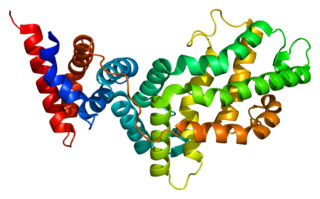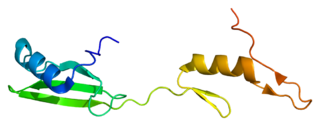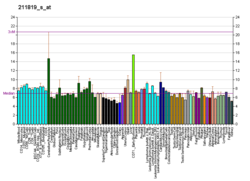
Signal transducing adaptor proteins (STAPs) are proteins that are accessory to main proteins in a signal transduction pathway. Adaptor proteins contain a variety of protein-binding modules that link protein-binding partners together and facilitate the creation of larger signaling complexes. These proteins tend to lack any intrinsic enzymatic activity themselves, instead mediating specific protein–protein interactions that drive the formation of protein complexes. Examples of adaptor proteins include MYD88, Grb2 and SHC1.

The epidermal growth factor receptor is a transmembrane protein that is a receptor for members of the epidermal growth factor family of extracellular protein ligands.

Growth factor receptor-bound protein 2, also known as Grb2, is an adaptor protein involved in signal transduction/cell communication. In humans, the GRB2 protein is encoded by the GRB2 gene.

Tyrosine-protein phosphatase non-receptor type 11 (PTPN11) also known as protein-tyrosine phosphatase 1D (PTP-1D), Src homology region 2 domain-containing phosphatase-2 (SHP-2), or protein-tyrosine phosphatase 2C (PTP-2C) is an enzyme that in humans is encoded by the PTPN11 gene. PTPN11 is a protein tyrosine phosphatase (PTP) Shp2.

Adapter molecule crk also known as proto-oncogene c-Crk is a protein that in humans is encoded by the CRK gene.

Phosphatidylinositol 3-kinase regulatory subunit alpha is an enzyme that in humans is encoded by the PIK3R1 gene.

Cbl is a mammalian gene encoding the protein CBL which is an E3 ubiquitin-protein ligase involved in cell signalling and protein ubiquitination. Mutations to this gene have been implicated in a number of human cancers, particularly acute myeloid leukaemia.

RAS p21 protein activator 1 or RasGAP, also known as RASA1, is a 120-kDa cytosolic human protein that provides two principal activities:

Crk-like protein is a protein that in humans is encoded by the CRKL gene.

SH3 domain-containing kinase-binding protein 1 is an adaptor protein that in humans is encoded by the SH3KBP1 gene.

Rap guanine nucleotide exchange factor 1 is a protein that in humans is encoded by the RAPGEF1 gene.

Cytoplasmic protein NCK1 is a protein that in humans is encoded by the NCK1 gene.

Tyrosine-protein kinase ABL2 also known as Abelson-related gene (Arg) is an enzyme that in humans is encoded by the ABL2 gene.

Flotillin-1 is a protein that in humans is encoded by the FLOT1 gene.

Cytoplasmic protein NCK2 is a protein that in humans is encoded by the NCK2 gene.

ArgBP2 protein, also referred to as Sorbin and SH3 domain-containing protein 2 is a protein that in humans is encoded by the SORBS2 gene. ArgBP2 belongs to the a small family of adaptor proteins having sorbin homology (SOHO) domains. ArgBP2 is highly abundant in cardiac muscle cells at sarcomeric Z-disc structures, and is expressed in other cells at actin stress fibers and the nucleus.

SH2B adapter protein 2 is a protein that in humans is encoded by the SH2B2 gene.

Src kinase-associated phosphoprotein 1 is an adapter protein that in humans is encoded by the SKAP1 gene.

Vinexin is a protein that in humans is encoded by the SORBS3 gene.

Suppressor of cytokine signaling 7 is a protein that in humans is encoded by the SOCS7 gene.




























